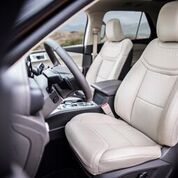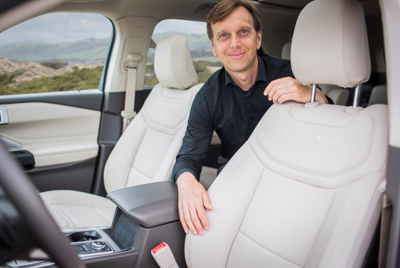Ford's Dr. Derriere Cures Road Trip Butt Blues - AAHHH Feels Good!
Ford's Dr. Derriere Cures Road Trip Butt Blues with Comfortable, Stylish Front Seats in All-New Ford Explorer
With more families hitting the road for vacation and the average commute time for U.S. workers growing, Ford team develops sleek new front seats for 2020 Explorer to provide drive-time relief and our ultimate in on-the-road comfort
New seats were created by the Ford global seating team, including Mike Kolich, whose Ph.D. in industrial and manufacturing systems engineering with an emphasis on seat comfort has prompted team members to dub him “Dr. Derriere”
New seat design, which undergoes a battery of tests to measure up to stringent Ford shape and softness standards, meets more than 100 engineering metrics for optimal comfort
DEARBORN, Mich., June 10, 2019 – Whether stuck in rush-hour traffic or cruising for hours on the open road on a summer vacation, commuting can be a real pain in the butt. Literally. Thankfully, one doctor has the prescription.
Supervisor Mike Kolich – Ford’s “Dr. Derriere” – and the Ford global seating and comfort team are tops when it comes to dreaming of new ways to cradle your bottom. A sleek and stylish new front seat offering in the all-new 2020 Ford Explorer maintains the stringent Ford standard for shape and softness and does so with a less cumbersome design that frees up space for second-row passengers.
 |
“Road trips can be largely defined by how comfortable people are – and when you get down to it, how comfortable our seats allow them to be,” said Kolich, whose Ph.D. in industrial and manufacturing systems engineering with an emphasis on seat comfort has earned him the moniker among Ford seating experts.
“As engineers, we’re thrilled with this new seat, but really it’s what our customers say and think that matters.”
That expectation, defined as the Ford comfort DNA, is measured largely by two factors – shape and softness. Kolich and team have maintained the comfort standard in the new front-row seat debuting on the all-new Explorer while eliminating some of the bulk by reducing the thickness of the seat back and shoulder area.
The new design aims to improve comfort for the more than 50 percent of family travelers who AAA reports will take a road trip this year, as well as the millions of workers who, according to the U.S. Census Bureau, spend a record average of 26 minutes driving to work each day.
The first-for-Ford design is the seating team’s latest innovation. For the all-new Explorer, the team started with its award-winning seat architecture that represents the nexus of all Ford seats regardless of vehicle type or size.
“What people see in a Mustang differs from what they see in an Explorer, but it’s all built on the same architecture,” said Kolich. “That architecture is the magic, in that it allows us to maintain consistency. These seats should feel similar to the seats in any other new Ford vehicle.”
What customers expect, and what Ford delivers, is a V-shaped design that provides torso support for a wider range of body types and sizes. In Explorer, available eight- and 10-way adjustable front-row seats cool occupants using a ventilation feature that draws warm air from the body rather than pushing cold air through seat perforations. Explorer ST and Platinum models come equipped with a multicontour system with unique massage patterns. New front-row back panels allow for a more sculpted appearance and improved second-row knee room.
Second-row seats feature new-to-Explorer EZ-entry functionality, allowing easy access to the third row without having to remove a child’s booster seat.
To maintain a comfort standard throughout the vehicle, each seat design is put through an exhaustive series of more than 100 in-lab tests – including initial softness and hardness distribution tests – that use proven metrics to validate that the seats deliver what customers expect.
“Our lab testing has changed the way we operate,” said Kolich. “Not long ago, the industry didn’t have measurable objectives like we do today. We would build a seat, and from there it was trial-and-error. We’re smarter than that today – we know what people expect.”



